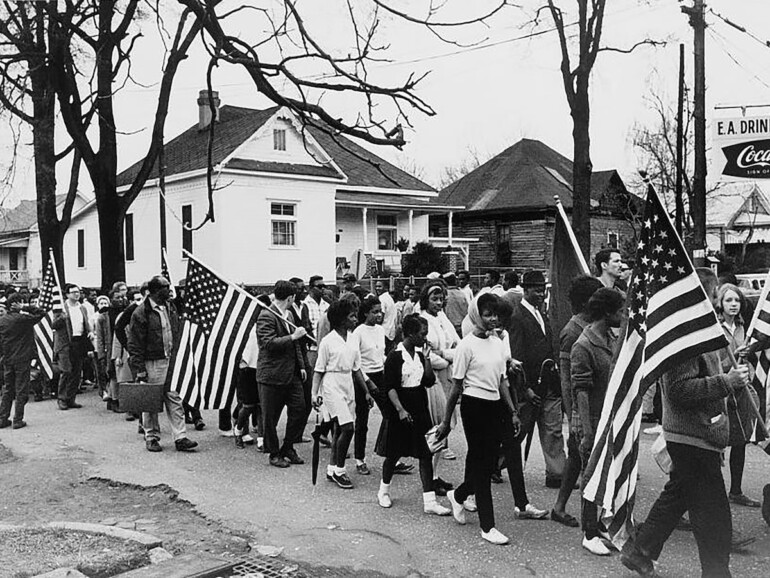In August 2023, 14 Marin County youth crossed the Edmund Pettus Bridge in Selma, Alabama, where Dr. Martin Luther King Jr., Rep. John Lewis and thousands of civil rights protestors marched almost 60 years prior. These students, aged eight to 20 years old, flew to Alabama as part of the Social Justice Youth Initiative, a program within Felecia Gaston’s Marin City nonprofit Performing Stars.
Their itinerary took the students and their chaperones to three Alabama cities, five museums and two historically Black universities. In and around Selma, they saw the Lowndes Interpretive Center and the National Voting Rights Museum before marching the bridge. From there, they went to Montgomery to visit the Legacy Museum, the Rosa Parks Museum and Alabama State University. Lastly, Tuskegee showed them the Tuskegee Airmen National Historic Site and Tuskegee University.
Ten students shared with us essays on their experiences. Their impressions ranged from shock at the horrors of slavery and Jim Crow, to determination in dismantling racism and honoring the triumphs of African Americans. Each student thanked Gaston and the TomKat Foundation, a donor, for making the trip happen. Click on any student’s name to read their essay.
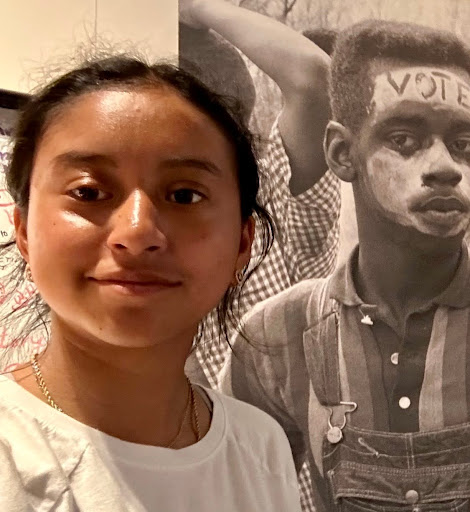
Emily Cauich, freshman at Tamalpais High School
My name is Emily Cauich, and I am a freshman from Tamalpais High School. Traveling to Alabama gave me the opportunity to learn and see the history up close and personal. I want to thank the TomKat Foundation and Ms. Felecia for giving me this opportunity to visit the South. Our Social Justice Initiative Group was able to visit powerful locations and museums that were all dedicated to the civil rights and history of Black Americans.
The civil rights movement was an era dedicated to activism for equal rights and treatment of African Americans in the United States. Montgomery, Alabama is its birthplace.
The National Voting Rights Museum is on the Selma side of the Edmund Pettus Bridge. This museum showed what black people had to go through to fight for their right to vote. After visiting that museum we walked across the Edmund Pettus Bridge with picket signs. It was nice to walk across the bridge with my friends holding up the picket signs that said, “Vote!” and having people honk in agreement with us.
The Legacy Museum is a museum that shows the history of slavery. This museum is built on the grounds of a former warehouse where hundreds of slaves were kept, waiting to be auctioned. Inside there were so many stories and artifacts that documented the practices racist white people forced on black people during the 17th and 19th centuries. It was emotional to see that black people did not have freedom in the past.
The Tuskegee Airmen History Museum is a museum that shows the history of the Tuskegee Airmen and is actually built in the hangars that they trained out of. We learned about the training that they went through. The Tuskegee Airmen are known as the “Red Tails” because of the tails being painted red on their fighter planes. It was very interesting being able to go to a place where war heroes once stood.
The Rosa Parks Museum is a museum dedicated to Rosa Parks and everything she did for the civil rights movement. She is known as the “mother of the civil rights movement”. At this museum, we saw a reenactment of the day she did not get up from her seat so a white man could sit down on a Montgomery bus. I think Rosa Parks is a very strong and admirable woman.
Visiting Alabama State University and Tuskegee University gave me the opportunity to see historic Black universities. I got to see the proud students walking around and getting ready for their new school year. Both campuses were really big and had some cool restaurants. I couldn’t help but think how lucky they were to be students at such a historical place.
This trip will always remain dear to my heart. I was allowed to do something that I probably wouldn’t have done on my own, and experienced so many new things. I had a great time, I got to spend time with my friends and we ate some good food. I’m so glad that I was able to go to Alabama and learn about the history that’s not included in my history book.
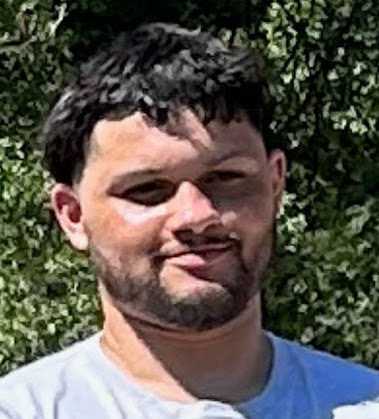
Trevion Clark, College of Marin
My name is Trevion Clark. I would like to start by thanking Ms. Felecia and the TomKat Foundation for the opportunity to travel to the South. I had never been to a different state other than Nevada.
While visiting Alabama we were able to visit The Legacy Museum, Rosa Parks Museum, as well as the National Voting Rights Museum. All of these museums were very profound and informative. Each location left me feeling overwhelmed with a lot of emotions about how black people were looked at as property and not human. It was a very difficult truth to digest. History comes with a price for some humanity that will never be paid back. Black people have endured a lot of injustice pressing forward to the current day, but still haven’t been repaid or even acknowledged in a way where it’s heartfelt.
I appreciated the information and how it was presented inside the museums. The Legacy Museum: From Enslavement to Mass Incarceration is located at a former warehouse where hundreds of slaves were kept, waiting to be auctioned. It displays the history of slavery and racism in America. When I think of what had to happen so we all can have the freedom some of us take for granted, it saddens me to think how we aren’t making more of an effort to make sure we keep the dream alive. The struggling truth was all wrapped up in these museums. As I walked down each exhibit and soaked in the pain, hurt and anger, one thing stayed on my mind… how strong everyone had to be! At that very moment, I realized how much strength it took to revisit these moments. To be able to stay strong in the midst of today’s events was passed down to me in ways I never really thought about until now.
Visiting the Historical Black Colleges, US Alabama University and Tuskegee University was a personal highlight of mine. I enjoyed seeing the campuses where so many have paved the way for future students like myself, the opportunity of an education where history actually took place, where dreams are made from the tears and hard work of the ancestors who once walked and lived. I will never allow myself to treat someone unkind because of the color of their skin. It’s not a reason to disrespect them in any way. Standing up for what’s right has always been a part of history, there are so many people who were never mentioned in books, museums, newspapers, or even in songs. But there were plenty of men and women who helped each other from different races and backgrounds, so I can continue that legacy in my now and near future.
In conclusion, our time in Montgomery Alabama & Selma was short enough to have a lasting effect on my cautiousness when dealing with other humans on this planet. Grateful for this opportunity to learn things a history book or school didn’t teach me.
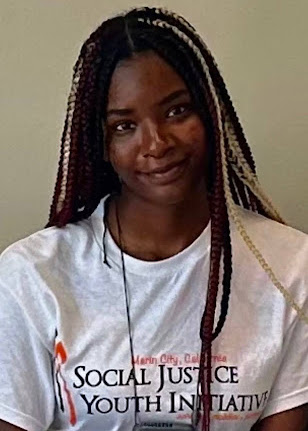
Antanasia Cook, senior at Tamalpais High School
My name is Antanasia Cook, I am a senior at Tam High School, and I was blessed to be able to go on a civil rights educational trip to Alabama. I would like to thank Ms. Felecia and the TomKat Foundation for making this trip a reality for me! Our Alabama trip was filled with a multiplicity of events that we not only got to see, but also film. The events consisted of visiting many places that pertain to Black excellence, Jim Crow, the Civil Rights Movement, and the continual fight for equality, such as museums, HBCUs, and memorials. My favorite events were the Legacy Museums and the ASU tour.
The Legacy Museum and the ASU tour was the most memorable and insightful event for me! The Legacy Museum in Montgomery, Alabama is basically an archive of African American history varying from enslavement to the current mass incarceration of African American men in the U.S. State Prisons. The museum has lots of informative and immersive exhibits like holograms of slaves being sold and videos showing the African diaspora. One specific exhibit that really attracted me was the first one, with the sculptures depicting African slaves buried in the sand. Seeing these human-like sculptures being in chains, separated from loved ones, with the look of pain and anguish on their faces, was really eye-opening and emotional, yet very comforting and beautiful at the same time. Me, knowing that though my ancestors were kidnapped, brought overseas, and still fought hard, felt empowering! Like, I too can get through troubling times. ASU was insightful as well. Before going on this trip, I never knew Alabama had another Historically Black College/University other than Tuskegee. The tour was amazing, with the school having lots of materials and buildings for all types of majors and interests, including a Forensics lab which I’m interested in. Not only did the education sound good but the people were very welcoming and very versatile. I even won a free shirt for asking and answering questions with the tour guides. It definitely made me consider ASU as a school I would want to go to!
Altogether, I really appreciate the opportunity to go on this trip! There is truly a difference between learning about the Civil Rights Movement in history books and videos online, and actually stepping foot where activists like Martin Luther King Jr. stood. Mothers, fathers, students, politicians, and regular people were beaten, some to death, for the rights that African Americans have today that we take for granted! I’m especially grateful that we were able to film this trip so we can show others back home and keep it for memories. I learned so much, while having a great time. The chaperones were very charismatic and energetic, yet very professional. We have times when we were all just laughing from silly mishaps like when D’Andre got stuck in the subway doors at Airport. Through our busy itinerary, we even had some downtime where we did things like went swimming in the pool and had a scary movie night! This whole experience was very indelible and I can’t wait to see the recording of it!
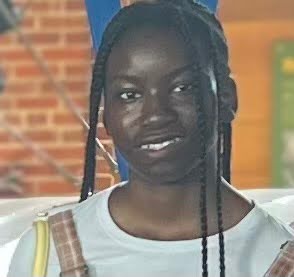
Jaliyah Cook, junior at Tamalpais High School
My name is Jaliyah Cook and I am a junior at Tamalpais High School. My trip to Alabama is an experience I will cherish. We went to many museums throughout our trip and learned about the many different struggles my people faced not too long ago. The great amount of courage and ambition my ancestors possessed to gain equal rights was very inspiring to me. From Tuskegee Airmen, Rosa Parks, Dr. Martin Luther King, to ordinary people, they all contributed to the fight for equal rights which they had been denied for far too long. Their actions still persist today.
Once we got to Alabama we got straight to work. After having a quick bite we were off to the first museum, the Lowndes Interpretive Center. I admit, I wasn’t too happy about it at first, being tired from the plane ride, but once our tour of the museum began I was excited to learn about the history of the fight for equal voting rights. Going through the museum, I learned about a place called “Tent City” which was home to the black Lowndes residents who were evicted by their white landlords. The second museum we visited was the National Voting Rights Museum. Throughout the museum, there were artifacts related to the march from Selma to Montgomery and cast footprints of individuals who participated in that march. The third museum stop was at the Legacy Museum. This museum dove deep into the history of slavery. It showed a lot of sensitive pictures of the things that happened during that time. The museum then dives into the American criminal justice system, and talks about the injustices that are being committed there. The fourth museum we visited was the Tuskegee Airmen National Historic Site. Here we saw the types of jobs the Tuskegee Airmen had to do for their training, like learning how to fix the propellers. The final museum visit was to the Rosa Parks Museum. This museum showcases Rosa Parks’ contributions to the civil rights movement, which ultimately led her to be named “the mother of the civil rights movement”. Not only did we learn about Alabama’s equal rights history, we also went on tours at Alabama State University and Tuskegee University.
I truly enjoyed my visits to Alabama State University (ASU) and Tuskegee University (TU). At ASU our tour guides took us around their campus, specifying what classes you may find in each building. Additionally, they taught us a little about frat culture and showed us their fraternity row. At TU the school year was not yet in session so it was very quiet, and there were lots of trees and grass, the campus was very green. Here our tour guide shared with us the history of TU, and showed us the trench that was created when the brickmakers were digging up dirt to make bricks when building the university. He also showed us a few buildings on campus, including a beautiful chapel with stained glass windows. On both tours, the tour guides talked about the importance of Historically Black Colleges and Universities, and how HBCUs came to be about. The trip was not all work and no play though. I was able to learn so much about Alabama’s history all while having fun in the process.
My peers and I enjoyed tons of leisure time. We spent time having fun at the pool and coming together for movie nights. We also always ate together and engaged in conversation about our trip. Additionally, we were graced with daily allowances that we got to spend on whatever we liked. I got a couple of souvenirs for myself and my family, and got to enjoy some of my favorite snacks during our outings. I am amazed at what me and my peers were able to do with the help of donations alone and I am incredibly grateful for Miss Felecia and the TomKat Foundation for making it all possible. I hope to keep the same valiant spirit my ancestors did in everything I do from now on. I wish to achieve great accomplishments in school and work to honor them.

Myles Donovan, Cava @ Sonoma
My name is Myles Donovan. I am 8 years old. I am the youngest member of the Social Justice Initiative Group. I had the best gift before Christmas this year. I was able to travel with 11 Teenagers and 8 adults to Montgomery Alabama and Selma this August.
I was so excited to fly on the plane again and go somewhere I had never been before. Our trip was very interesting with a lot of eventful activities. We were all so excited to get to Montgomery and see all the museums and I was curious on what the South would look like. To my surprise, there were a lot of trees and open space. There were also a lot of abandoned houses with plenty of empty fields. I couldn’t help but to think if there were people who were never found inside those wooded areas.
I felt like we had traveled back in time, only there were no horses or signs that said, “NO BLACKS”! This time we were a group of 22 people made up of different races and ages with different backgrounds traveling to see how far we have come. This trip had me feeling all sorts of emotions. Learning about my history is important, BLACK PEOPLE are truly a very important part of HISTORY!
While visiting the Legacy Museum I remembered holding my mom’s hand really tight feeling a lot of sadness, confusion, and anger all at once. At one point I even closed my eyes and my mom said to me “It’s ok take a deep breath and remember this is what it took to get us where we are today. These children, men, and women were all brave” she said. I thought to myself this takes courage to even walk through these exhibits and not feel overwhelmed with anger towards the white race. I wondered how the white people who were also at the museum felt about their ancestors, how did it make them feel? Were they ashamed and or sorry for the way they are talked about in the history books?
Rosa Parks Museum was really nice. There was a real bus in the museum that acted out the scene when Rosa Parks refused to get up so a white man could sit down. I remember thinking that’s not fair and why would he feel like taking a lady’s seat. In my mind that wasn’t right at all no matter what color she was, because she was an elder and a lady. I remember thinking white people didn’t have a lot of manners in the past.
Lowndes Interpretive Center, Tent City exhibit showed visitors what tent city looked like. It was very interesting to see how the blacks had to sleep with a small cot and blanket and a gun beside them because of the protection they needed to feel safe. It became clear to me that being Black during these times was hard and took a lot of courage and faith to get through. I remember telling my mom that we had to come from a STRONG FAMILY, if we didn’t our family line would have been killed off. I really feel a strong appreciation for my family that was born during these times and also a feeling of sadness that there were so many mean and evil white people during these times. Edmund Pettus Bridge gave me different feelings. I felt proud and honored to walk on the very bridge Dr. Martin Luther King Jr. John Lewis, and Frederick Douglas Reese to name a few that marched across. I remember seeing the bridge before we got there. It seemed so big to march across, but it was the reason and the purpose of the walk that made the bridge seem bigger. When we all were walking the bridge I was looking around and the sun was shining on us. It felt like the angels of the Edmund Pettus Bridge were shining down on all of us, giving us strength to continue the fight for the rights that we deserve!
My favorite stop was the University of Tuskegee. The campus was very big with BIG brick buildings, lots of open space, and friendly people. We had a really cool tour guide, he was a student there and it made the tour more personal. He took us to all the landmarks, I even got a picture in front of George Washington Carver’s building and other cool places. Walking on one of the first Historically Black College and University campuses was a highlight. I told my mom how cool it would be that I would choose to go there for college and be the first in my family to attend an HBCU. My siblings didn’t attend an HBCU, so I would be the first. After going on this fun and emotional history trip, I want to be the first to do something and be a part of history too!
Thanks again to the TomKat Foundation and Ms. Felecia Gaston for making it possible for me to travel through history. I learned a lot that I haven’t seen so far in the history books. Whenever we talk about this in my future history classes, I’ll be able to share my experience.
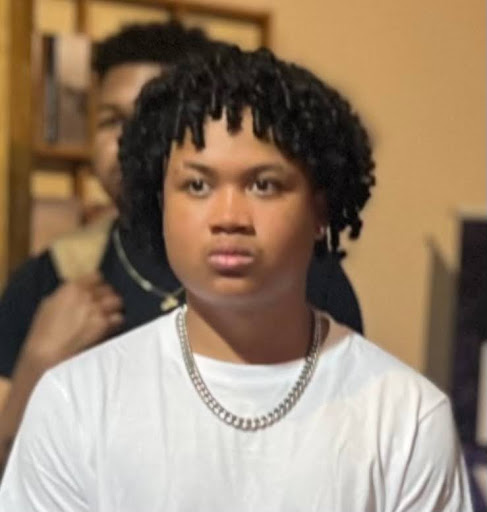
Siyon Farin, Sonoma State University
My name is Siyon Farin, and I am a student at Sonoma State University. Before visiting Alabama, I had never been given the opportunity to reflect upon my roots, nevertheless indulge in the deep history of slavery and the civil rights movement. Here in America, matter of fact, here in Marin County, schools don’t completely teach their students about black history. All my life, I have attended predominantly white schools that never take teaching about black culture and black history seriously. Going to school in Marin County, you will be taught about all the great achievements that white people have accomplished with all the money they had. However, our schools rarely teach about the adversity black people have had to overcome in order to live amongst others as equal human beings. And when they do teach black history, it is always a brief lesson or just a couple of classes. Even today, as I am attending a predominantly white institute, SSU doesn’t have a class dedicated to African-American history. There is just “U.S. History” which is completely separate from African-American studies and history. From what I learned in Alabama, America wouldn’t be America if it wasn’t for black people. In this essay, I will be going into detail about my experience in Alabama. I will include what I observed, what I learned, and what resonated with me the most.
First and foremost, I would like to thank Felecia Gaston and all the donors who made this trip a possibility. What I observed about Alabama is the most obvious observation any average person from the West Coast visiting the South would say. That is how different and unique Alabama is from California. Although adjusting to the change of climate may have been quite the struggle, the scenery of the south was a sight to behold. The locals are comfortable enough to greet you without knowing you. If you aren’t from the South, greeting random people isn’t a common practice. Adding onto that point, when we had the pleasure of visiting Tuskegee and Alabama State University, I noticed how friendly and energetic all the college students were with their peers. It was as if everyone knew everyone while matching each other’s high-volume energy in public. This caught my attention because that vibe isn’t something I see at my school and most likely isn’t seen at most schools in California. Furthermore, as for what I learned, slavery, segregation, and discrimination didn’t necessarily end in the South right when the laws were passed. From what I learned in the Legacy Museum, it took many additional years for the South to follow the Slavery Abolishment Law. White slave owners felt they would lose money and power when this law was passed, so they didn’t submit to the law. This same situation also happened when Jim Crow laws were put to an end. And that brings me to my last point. Concluding the trip, something that truly resonated with me was the lynching memorial. When we first stepped foot into the memorial, I thought there would be 1-2 names for each gravestone for each person or two that was lynched. I was wrong. There were many names, up to 12 names on a gravestone. Secondly, while I was reading the cases for why each person was lynched, I questioned each reason, for they were all unreasonable. For example, one case read “For not letting a white man beat him in a fight”. As I continued to read the various cases, I came to the conclusion of how inhumane people have been in the past couple of centuries.
All in all, the trip to Alabama was an intriguing experience and opportunity. I would like to say thank you to the TomKat Foundation and Ms. Felecia for putting this trip together. I was able to expand my mindset on what I didn’t know and what we are not being taught: the United States is built on black labor. Overall, I am grateful for this life that has been given to me.
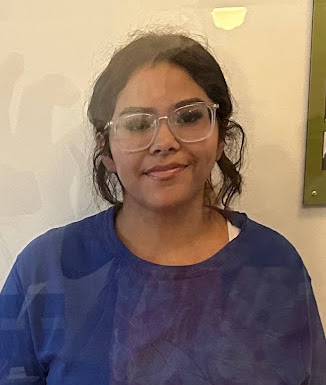
Brenda Lara, freshman at Tamalpais High School
My name is Brenda Lara, and I’m a 14-year-old freshman at Tamalpais High School. My experience in Alabama was emotional yet amazing. I learned a lot more about our history by going to different museums that showed me what black people experienced. These museums showed the unfair treatment they endured that led up to the civil rights movement, what they had to go through during their time as slaves, and how they trained to become airmen. I learned that the life of a black person in America is so much harder than I could’ve ever imagined.
As soon as we landed in Alabama we went to the Lowndes Interpretive Center. At this museum, we were shown a video of the horrible things that happened to black people during the civil rights movement. It was hard to watch that video because it showed people getting beaten by the police, bitten by big dogs, stomped on by horses, and hosed down with strong fire hoses. After that, we went to the National Voting Rights Museum in Selma. At this museum, we were given unique details about a very important day in civil rights history, Bloody Sunday. We then marched across the Edmund Pettus Bridge, holding up signs that said “VOTE”. It was mind-blowing to walk across the same bridge, where important civil rights figures like Dr. Martin Luther King Jr. marched. But at the same time, it felt surreal knowing that those important figures, along with so many others, were beaten down on that same bridge. Once we were done with our march we made a quick stop to Brown Chapel Church. This church is an important part of civil rights history because the planning for the march from Selma to Montgomery happened here. It also was a safe haven for injured marchers. It really amazes me, how resilient black people were during the civil rights movement, and how they continue on with their resiliency today.
The Legacy Museum stood out to me. It was hard at the beginning, because the first thing you see when you walk into the museum is a bunch of statues of adults and kids in chains. As you continue through you learn about the different slave trades, and see how hard life was for slaves. From excruciating lashings, to the separation of families, it was all very sad. It then connects slavery to our modern-day world and explains how we are still being enslaved through the mass incarceration system. I learned of the injustices that people of color continue to face, and how the justice system doesn’t really work in our favor. I will remember the information I learned at the Legacy Museum and make sure that I do my part to end racism in America.
On day three of our Alabama trip, we were able to walk through the same hangars as the Tuskegee Airmen. At the Historic Tuskegee Airmen Museum, we got to learn about their training and explore the historic hangars. It was really hot, and it made me think how did those guys even make it through?! But even though it was hot, I had fun going through the different rooms. Each room was designed as if it were 1940, which was really cool. There were also some old school style phones scattered around the hangar, and when you picked them up you would hear the oral history of some of the airmen. Going to the Historic Tuskegee Airmen Museum has put my respect for the Tuskegee Airmen on a whole other level!
Going to Alabama was very interesting. Learning about the hardships that black people had gone through was uncomfortable, but needed. Each museum gave me a better understanding of why people are so passionate about correcting the injustices that black people still face to this day. If it were up to me, I would make sure that all schools across America learn everything that I learned on this trip. I would like to thank Ms. Felecia, the TomKat Foundation, and everyone who played a part in putting this trip together. I hope I get a chance to go back to Alabama, the people down there are very kind and hospitable.

Bradley Page-Harris, sophomore at College of Marin
My name is Bradley Page-Harris, and I am a sophomore at the College of Marin. From August 14 to August 19, 2023, I as well as many other Marin City youth were blessed to visit Montgomery, Alabama. Usually, when people visit out of state, they see it as a vacation more than a learning opportunity. However, the Marin City Social Justice Youth Initiative group seized the opportunity to take in information that had never been presented to us. Before I even get into my essay, I would like to show my appreciation and thank the TomKat Foundation for their generous donation, and to Ms. Felecia Gaston, because she is the heartbeat of our SJYI group. Without her sacrifices as a leader, we wouldn’t have been able to attend multiple monuments and museums in Montgomery.
The very first action as a group that we partook in was a march across the Edmund Pettus Bridge This bridge is the pathway that connects Selma and Montgomery. During this march, I was able to acquire amazing footage of our organization while recreating the 1965 march to generate voting rights for black citizens. When participating in this march, one of our chaperones Kenneth Wayne Price. He explained how these protestors were chased for miles and had tear gas thrown at them, many, if not all, were beaten and some of them even died. Hearing him say that made me realize the intense sacrifices that our ancestors and previous generations made to create opportunities for minorities. I’ve grown more and more grateful for our ancestors’ honor and dignity that they had to keep in order to fight for the future.
One other takeaway that I’ve gained from our educational trip to Montgomery was learning about heartbreaking actions and consequences taken on slaves. Another historical monument that we visited was the Equal Justice Initiative monument. Walking through that monument was such an emotional experience. It took time for me to process the horrific actions taken on slaves. Reading about the physical abuse, sexual abuse, and the death toll was a lot for me to soak in. At the monument we walked around multiple plaques and tombstones which had the names of slaves, the year they were born to the year they were lynched, and the place where they were lynched. Most of the tombstones said “unknown” because the slaves that were lynched didn’t have identities and weren’t served any justice. That’s not even the worst part about it. When walking through, there was a stack of “reasons” why our ancestors were lynched. Here are two of the many dumb reasons for the death of our previous generations.
- Writing a note to a white woman
- For not letting a white man beat a black man in a fight
First of all, slaves were not allowed to read or write, so how did he write a note to a white woman!!?? This makes me so upset because Slave owners were just making up so many excuses to execute black people. Degrading them, and separating them from their families. Secondly, why is a slave supposed to let a white man beat him in a fight? Either way, the black man was going to take a beating no matter the outcome. Black people were not treated like human beings, and shown no respect, and it was like their lives were just replaceable. If you kill one of your slaves, then you can just purchase another slave for cheap. This is just so heartbreaking and it makes me so upset that we had to go through that for over 400 years.
The learning experience that was presented to us by Ms. Felecia was the biggest blessing that I could have ever gained. There was so much information that I wouldn’t have obtained without Ms. Felecia. She really wants us to learn and gain the advice that we weren’t taught in school. These facts need to be taught throughout the entire school year. Black History Month is only taught during the month of February, which is clearly not enough time for scholars to learn about the battles and oppression that our ancestors had to face on a daily basis. When I graduate college I would love to take the future youth to Mongomery for the same opportunity.
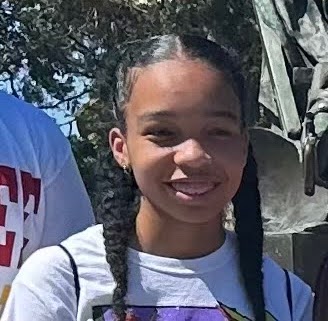
Savannah Page-Harris, sophomore at Tamalpais High School
My name is Savannah Page-Harris and I am a sophomore at Tamalpais HS. In August of 2023, myself and a group of teens known as the Social Justice Youth Initiative Group had the opportunity to go to Montgomery, Alabama to learn more about the Civil Rights movement. I am really grateful that I had the opportunity to go and deepen my knowledge.
Something that really stuck out to me was The Legacy Museum. In this museum, we got to walk through and experience the slavery period and learn of its connection to mass incarceration. We got to see holograms of some slaves and we even got to pick up the phone and listen to the stories of African Americans who are incarcerated. This museum was the most emotional for me because of all the raw details it showed. Leaving out of The Legacy Museum I couldn’t help but think justice was never fully served.
The Equal Justice Initiative Memorial is an extension of the Legacy Museum. Here we got to walk around and read all the names of the people who were lynched. It was emotional but so cool to be able to walk underneath the plaques and fully get the experience. What made it even more emotional were the reasons some slaves got lynched. Some slave owners would lynch a random slave if they couldn’t find the other they were looking for. Some slaves lost their lives if they didn’t try and help find another slave.
I am grateful for Ms. Felecia and the TomKat Foundation who funded this trip. This visit to Alabama has sparked my interest in diving further into my ancestors’ past and has reminded me to always strive to change history.
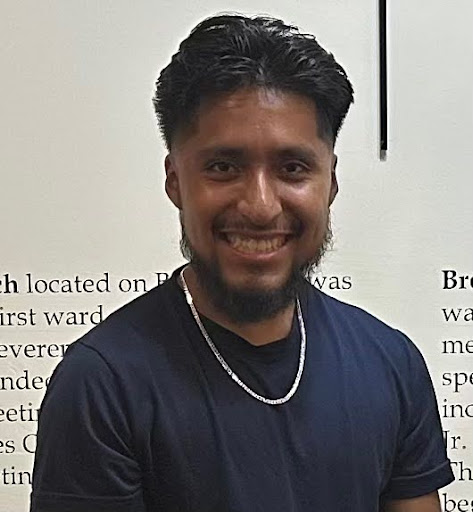
Moises Zarate, Sonoma State University
My name is Moises Zarate, I am currently taking classes at Sonoma State University, and this is my first time going to Alabama. First and foremost, I would like to thank the TomKat Foundation and Ms. Felecia. Without them, this trip wouldn’t have happened. Alabama holds a significant place in American history, particularly in the context of the Civil Rights Movement and the historical horrors of slavery. Visiting this state allows one to explore the profound impact of the past, emphasizing how hearing about these experiences differs from seeing them firsthand.
Hearing vs. Seeing the Horrors of Slavery
Understanding the horrors of slavery is a crucial aspect of comprehending the Civil Rights Movement’s significance. Hearing about these experiences from textbooks or lectures provides some insight, but it often lacks the emotional connection that comes from witnessing the physical remnants of this painful history. Alabama’s role in slavery, with its plantation economy and reliance on enslaved labor, is starkly apparent when one visits the historical sites and museums dedicated to preserving this history.
The Edmund Pettus Bridge
One of the most iconic landmarks in Alabama associated with the Civil Rights Movement is the Edmund Pettus Bridge in Selma. This bridge witnessed the brutality of “Bloody Sunday” on March 7, 1965, when peaceful civil rights marchers were greeted with violence by state troopers on the Montgomery side. Walking across this bridge feels like a journey through history itself. The physical act of traversing the same ground where civil rights activists risked their lives to fight for equality brings history to life.
Walking the Edmund Pettus Bridge is a powerful reminder of the sacrifices made during the Civil Rights Movement. It is an experience that allows individuals to appreciate the courage and determination of those who walked this path before, and it underscores the difference between hearing about this history and personally connecting with it through a physical encounter.
The Legacy Museum
The Legacy Museum, located in Montgomery, serves as a poignant testament to the horrors of slavery. Walking through the museum, I was confronted with exhibits and artifacts that vividly depict the dehumanizing conditions endured by enslaved individuals. From shackles and whipping posts, to personal stories and documents, the museum offers a somber and visceral experience of the past. Seeing these artifacts and reading firsthand accounts allowed me to connect with the history on a deeply emotional level, providing a more profound understanding than mere hearsay ever could.
Alabama’s historical significance in the Civil Rights Movement and the horrors of slavery is best understood by seeing and experiencing it firsthand. The Legacy Museum and the Edmund Pettus Bridge provide tangible connections to this past, allowing me to grasp the depth of the struggles and sacrifices made. While hearing accounts of these events is important, standing where history unfolded is a transformative experience that leaves a lasting impact, making the past more tangible and real. Alabama’s legacy in the Civil Rights Movement reminds us that history is not just something we hear about; it’s something we can walk through and feel in our bones.

